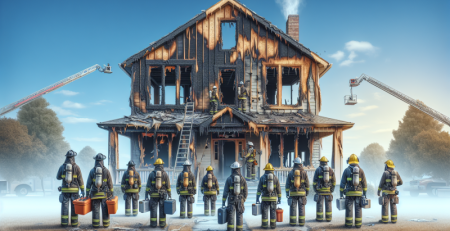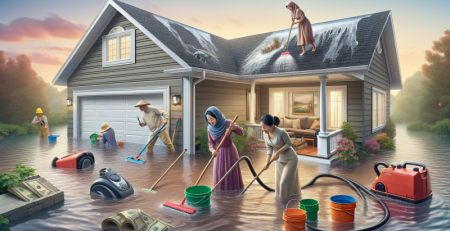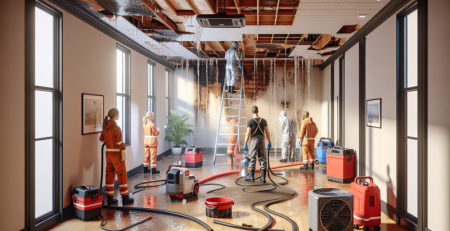Understanding Your Homeowners Insurance for Restoration
Homeowners insurance is a crucial aspect of protecting your property, especially when it comes to restoration after unexpected events like water, mold, or fire damage. Understanding your homeowners insurance policy can help you navigate the complexities of claims and ensure you receive the coverage you need during a restoration process. At Kraus Restoration, NJ’s leaders in water, mold, and fire damage restoration, we emphasize the importance of being informed about your insurance options. With our 24/7 emergency services and rapid response team, we are here to assist you every step of the way. Our IICRC certified experts serve Central and Northern NJ, ensuring that you have the support you need when disaster strikes. Call us at (973) 886-2021 to learn more about how we can help you understand your homeowners insurance and facilitate a smooth restoration process.
What is Homeowners Insurance and Why is it Important for Restoration?
Homeowners insurance is a vital form of coverage designed to protect homeowners from financial losses due to various risks associated with owning a home. This type of insurance typically covers damage to the home itself, personal property within the home, and liability for injuries that occur on the property. Understanding homeowners insurance is crucial, especially when it comes to restoration after a disaster, such as a fire, flood, or mold infestation.
When a home is damaged, the restoration process can be overwhelming. Homeowners insurance plays a critical role in facilitating this process by providing the necessary financial support to repair or replace damaged property. According to the Insurance Information Institute, about 97% of homeowners have some form of insurance, highlighting its importance in safeguarding one of the most significant investments in a person’s life.
In the context of restoration, homeowners insurance can cover a variety of scenarios. For instance, if a pipe bursts and causes water damage, the insurance policy may cover the costs associated with water cleanup and repairs. Similarly, if a fire damages the home, the policy can help cover the costs of fire cleanup and rebuilding efforts. This financial backing is essential for homeowners who may not have the resources to pay for extensive repairs out of pocket.
Moreover, homeowners insurance typically includes liability coverage, which protects homeowners from legal claims arising from injuries that occur on their property. This aspect is particularly important during restoration, as contractors and restoration professionals may be working on-site. If an accident occurs, liability coverage can help protect the homeowner from potential lawsuits.
It is also important to note that not all homeowners insurance policies are created equal. Coverage can vary significantly based on the provider and the specific policy. Homeowners should carefully review their policies to understand what is covered and what is not. For example, some policies may exclude certain types of damage, such as flood damage, which may require separate flood insurance. Understanding these nuances can help homeowners make informed decisions about their coverage and ensure they are adequately protected during restoration.
In addition to understanding the coverage, homeowners should also be aware of the claims process. When damage occurs, it is essential to document the damage thoroughly and contact the insurance provider as soon as possible. This prompt action can help expedite the claims process and facilitate quicker restoration efforts. Homeowners should also keep records of any repairs or restoration work done, as this documentation can be crucial when filing a claim.
The importance of homeowners insurance in restoration cannot be overstated. It not only provides financial support but also offers peace of mind during a challenging time. Homeowners can focus on restoring their homes and getting back to normal life, knowing that they have the necessary coverage in place.
In conclusion, homeowners insurance is an essential component of homeownership that plays a significant role in the restoration process. It protects homeowners from financial losses due to damage and liability, ensuring that they can recover from disasters without incurring overwhelming costs. Homeowners should take the time to understand their policies, review their coverage, and be proactive in the claims process to ensure a smooth restoration experience. For more information on how to navigate the complexities of homeowners insurance and restoration, you can visit our about page or explore our services to see how we can assist you in your restoration needs. Remember, being informed is the first step towards effective home protection and restoration.
Key Coverage Areas in Homeowners Insurance Policies
Homeowners insurance is a crucial safeguard for property owners, providing financial protection against various risks associated with homeownership. Understanding the key coverage areas in homeowners insurance policies is essential for ensuring that you have adequate protection for your home and belongings. Typically, homeowners insurance encompasses several primary coverage areas, each designed to address specific risks and needs.
One of the most significant components of homeowners insurance is dwelling coverage. This aspect protects the physical structure of your home, including the walls, roof, and built-in appliances, against perils such as fire, windstorm, hail, and vandalism. In the event of a covered loss, dwelling coverage helps pay for repairs or rebuilding costs, ensuring that your home can be restored to its original condition. It is vital to assess the replacement cost of your home accurately to ensure you have sufficient coverage.
Another critical area is personal property coverage, which protects your belongings within the home. This includes furniture, electronics, clothing, and other personal items. If these possessions are damaged or stolen due to a covered event, personal property coverage can help you recover the value of your items. It is advisable to create an inventory of your belongings and understand the limits of your policy, as some high-value items may require additional coverage or endorsements.
Liability coverage is another essential component of homeowners insurance. This coverage protects you in the event that someone is injured on your property or if you accidentally cause damage to someone else’s property. Liability coverage can help cover legal fees, medical expenses, and any settlements or judgments that may arise from such incidents. Having adequate liability coverage is crucial for protecting your financial assets and ensuring peace of mind.
Additional living expenses coverage, often referred to as loss of use coverage, is also an important aspect of homeowners insurance. If your home becomes uninhabitable due to a covered loss, this coverage helps pay for temporary living expenses, such as hotel bills and meals, while your home is being repaired or rebuilt. This coverage can be invaluable during the restoration process, allowing you to maintain your standard of living despite the disruption.
In addition to these primary coverage areas, homeowners insurance policies may also include various endorsements or riders that provide additional protection. For instance, you may want to consider adding coverage for specific risks such as flood or earthquake damage, which are often not included in standard policies. Understanding the specific risks in your area can help you determine whether additional coverage is necessary.
It is also essential to review the exclusions in your homeowners insurance policy. Common exclusions may include damage caused by lack of maintenance, wear and tear, or certain natural disasters. Being aware of these exclusions can help you take proactive measures to mitigate risks and ensure that you are adequately protected.
When selecting a homeowners insurance policy, it is advisable to work with a knowledgeable insurance agent who can help you navigate the various options and tailor a policy that meets your specific needs. Regularly reviewing and updating your policy is also crucial, especially after significant life changes such as renovations, acquiring new valuables, or changes in your family structure.
In conclusion, understanding the key coverage areas in homeowners insurance policies is vital for protecting your home and personal belongings. By familiarizing yourself with dwelling coverage, personal property coverage, liability coverage, and additional living expenses coverage, you can make informed decisions about your insurance needs. For more information on how to protect your home and belongings, consider exploring our services or contact us for personalized assistance. Being proactive in understanding your homeowners insurance can provide peace of mind and financial security in times of need.
Common Exclusions and Limitations in Restoration Coverage
When it comes to homeowners insurance, understanding the nuances of your policy is crucial, especially regarding restoration coverage. While many policies offer extensive protection for damages to your home, there are common exclusions and limitations that homeowners should be aware of. These exclusions can significantly impact your ability to recover costs associated with restoration after a disaster, making it essential to read and comprehend your policy thoroughly.
One of the most prevalent exclusions in homeowners insurance is damage caused by natural disasters. Many policies do not cover damages resulting from floods, earthquakes, or landslides unless you have purchased additional coverage. For instance, if your home suffers water damage due to a flood, standard homeowners insurance may not provide the necessary financial support for restoration. Homeowners in flood-prone areas should consider investing in a separate flood insurance policy to ensure they are adequately protected. Similarly, earthquake insurance is often a separate policy that must be purchased to cover damages from seismic activity.
Another common limitation in restoration coverage is related to wear and tear. Homeowners insurance is designed to cover sudden and accidental damages rather than gradual deterioration. For example, if your roof leaks due to age and lack of maintenance, your insurance may not cover the repair costs. Insurers typically expect homeowners to maintain their properties adequately, and failure to do so can result in denied claims. Regular maintenance and timely repairs are essential to prevent issues that could lead to significant damage and costly restoration efforts.
Additionally, many policies have specific limits on coverage amounts for certain types of damage. For instance, while your policy may cover fire damage, it might only provide a limited payout for personal property lost in the fire. Homeowners should review their policy limits carefully and consider purchasing additional coverage or endorsements for high-value items or specific risks. This is particularly important for homeowners with valuable collections, artwork, or high-end appliances that may exceed standard coverage limits.
Another area where homeowners may encounter limitations is in the coverage for mold damage. Many insurance policies have strict exclusions for mold remediation, especially if the mold growth resulted from negligence or lack of maintenance. If mold develops due to a long-term leak that was not addressed, your insurer may deny the claim. Homeowners should take proactive measures to prevent mold growth by addressing water issues promptly and ensuring proper ventilation in areas prone to moisture.
Moreover, some policies may exclude damages caused by pests or vermin. If your home suffers damage due to a rodent infestation or termite activity, your insurance may not cover the restoration costs. Homeowners are encouraged to invest in regular pest control measures to mitigate these risks and protect their homes from potential damage.
Lastly, it is essential to understand the concept of deductibles in your homeowners insurance policy. A deductible is the amount you must pay out of pocket before your insurance coverage kicks in. Higher deductibles can lower your premium but may also mean you will bear more of the restoration costs in the event of a claim. Homeowners should carefully consider their financial situation and choose a deductible that balances affordability with adequate coverage.
In conclusion, understanding the common exclusions and limitations in restoration coverage is vital for homeowners. By being aware of these factors, you can make informed decisions about your insurance policy and take proactive steps to protect your home. Regularly reviewing your policy, maintaining your property, and considering additional coverage options can help ensure that you are prepared for unexpected events. For more information on how to protect your home and navigate the complexities of homeowners insurance, visit our about page or explore our services to find the right solutions for your needs. If you have specific questions or need assistance, feel free to contact us for expert guidance.
How to File a Claim for Restoration After Damage
Filing a claim for restoration after damage to your home can be a daunting process, but understanding the steps involved can make it much more manageable. Homeowners insurance is designed to protect you from unexpected events, such as fire, water damage, or natural disasters. When you experience damage, the first step is to assess the situation and document the extent of the damage. Take clear photographs and make a detailed list of affected areas and items. This documentation will be crucial when you file your claim.
Once you have gathered your evidence, it is essential to contact your insurance company as soon as possible. Most insurance policies have specific time frames within which you must report damage. When you call, be prepared to provide your policy number and a brief description of the damage. The insurance representative will guide you through the claims process, explaining what information they need and what steps you should take next.
After reporting the damage, your insurance company will likely assign an adjuster to your case. The adjuster will visit your home to assess the damage firsthand. It is beneficial to be present during this visit, as you can point out specific areas of concern and provide the documentation you collected earlier. The adjuster will then prepare a report that outlines the damage and estimates the cost of restoration.
Once the adjuster has completed their assessment, you will receive a claim decision from your insurance company. If your claim is approved, they will provide you with a payout amount based on the terms of your policy. It is important to review this amount carefully. If you believe the offer is insufficient, you have the right to appeal the decision. Gather additional evidence and communicate with your insurance company to negotiate a fair settlement.
In the meantime, it is crucial to begin the restoration process as soon as possible to prevent further damage. Depending on the type of damage, you may need to hire professionals for cleanup and repairs. For instance, if you have experienced water damage, consider contacting a specialized water cleanup service to mitigate the effects and prevent mold growth. Similarly, if your home has suffered from fire damage, a fire cleanup service can help restore your property efficiently.
Throughout this process, keep detailed records of all communications with your insurance company, including dates, times, and the names of representatives you speak with. This information can be invaluable if you encounter any issues or delays with your claim. Additionally, maintain copies of all documents related to your claim, including your policy, the adjuster’s report, and any correspondence.
If you find the claims process overwhelming, consider seeking assistance from a public adjuster. Public adjusters are professionals who can help you navigate the claims process and ensure you receive a fair settlement. They work on your behalf, representing your interests and advocating for the compensation you deserve.
Finally, once your claim is settled and restoration is underway, take the opportunity to review your homeowners insurance policy. Ensure that you have adequate coverage for future incidents and consider discussing any changes with your insurance agent. Understanding your policy can help you make informed decisions and avoid potential pitfalls in the future.
In summary, filing a claim for restoration after damage involves documenting the damage, reporting it to your insurance company, working with an adjuster, and beginning the restoration process promptly. By following these steps and seeking professional help when necessary, you can navigate the claims process more effectively and restore your home to its former condition. For more information about restoration services, you can visit our services page or reach out through our contact page for personalized assistance.
Tips for Choosing the Right Homeowners Insurance Policy
When it comes to safeguarding your home and assets, selecting the right homeowners insurance policy is crucial. This decision not only protects your property but also provides peace of mind in the event of unforeseen disasters. To make an informed choice, consider the following tips that can guide you through the process of selecting the best policy for your needs.
First, assess your coverage needs. Take a thorough inventory of your home and belongings, including furniture, electronics, and valuables. Understanding the total value of your possessions will help you determine how much coverage you need. Additionally, consider the structure of your home, including its age, materials, and any unique features that may require specialized coverage. This assessment will provide a solid foundation for your policy selection.
Next, familiarize yourself with the different types of homeowners insurance policies available. The most common types include HO-1, HO-2, HO-3, and HO-5 policies, each offering varying levels of coverage. An HO-3 policy is the most popular choice as it provides comprehensive coverage for your home and personal property against a wide range of risks. However, if you have high-value items or unique features in your home, you may want to explore an HO-5 policy, which offers broader coverage for personal property. Understanding these distinctions will help you choose a policy that aligns with your specific needs.
It is also essential to evaluate the deductibles associated with your policy. A deductible is the amount you must pay out of pocket before your insurance coverage kicks in. Generally, policies with lower premiums come with higher deductibles, and vice versa. Consider your financial situation and how much you can afford to pay in the event of a claim. Striking a balance between premium costs and deductible amounts is key to finding a policy that fits your budget while still providing adequate protection.
Another important factor to consider is the reputation and financial stability of the insurance company. Research various insurers to find one with a strong track record of customer service and claims handling. Reading customer reviews and checking ratings from independent agencies can provide insight into how well an insurer manages claims and supports its policyholders. A reliable insurance company will not only offer competitive rates but also be there for you when you need to file a claim.
Additionally, inquire about discounts that may be available to you. Many insurance companies offer discounts for various reasons, such as bundling multiple policies, having a security system, or being claim-free for a certain period. Taking advantage of these discounts can significantly reduce your premium costs. Be sure to ask your insurance agent about any potential savings that you may qualify for.
It is also wise to review the policy’s exclusions and limitations. Every homeowners insurance policy has specific exclusions that outline what is not covered. Common exclusions may include damage from floods, earthquakes, or lack of maintenance. If you live in an area prone to certain risks, you may need to purchase additional coverage or a separate policy to protect against those specific threats. Understanding these exclusions will help you avoid surprises when it comes time to file a claim.
Lastly, consider working with an insurance agent or broker who can guide you through the process. An experienced professional can help you navigate the complexities of homeowners insurance, answer your questions, and provide personalized recommendations based on your unique situation. They can also assist you in comparing quotes from different insurers to ensure you are getting the best coverage at the most competitive price.
In conclusion, choosing the right homeowners insurance policy requires careful consideration of your coverage needs, the types of policies available, deductibles, the insurer’s reputation, potential discounts, exclusions, and the guidance of a knowledgeable professional. By taking these factors into account, you can make an informed decision that will protect your home and belongings for years to come. For more information on how to safeguard your home and ensure it is adequately protected, visit our about page or explore our services to see how we can assist you in your restoration needs.
Understanding the Role of Deductibles in Restoration Claims
When navigating the complexities of homeowners insurance, understanding the role of deductibles in restoration claims is crucial for homeowners. A deductible is the amount you are responsible for paying out of pocket before your insurance coverage kicks in. This amount can significantly impact the overall cost of a restoration project following damage to your home, whether from water, fire, or mold.
Homeowners insurance policies typically have different deductible options, which can range from a few hundred to several thousand dollars. The choice of deductible can affect your premium; generally, a higher deductible results in lower monthly payments, while a lower deductible leads to higher premiums. It is essential to strike a balance that suits your financial situation and risk tolerance.
When filing a restoration claim, the deductible is subtracted from the total cost of the damage. For instance, if your home sustains $10,000 worth of damage and you have a $1,000 deductible, your insurance will cover $9,000 of the restoration costs. This means that understanding your deductible is vital in assessing how much you will need to pay out of pocket and how much your insurance will cover.
Different types of damage may also have varying deductible amounts. For example, some policies have separate deductibles for specific perils, such as wind or hail damage, which can be higher than the standard deductible. This is particularly relevant in areas prone to natural disasters, where homeowners may face significant out-of-pocket expenses.
It is also important to consider the timing of your claim. If you experience multiple incidents within a short period, you may have to pay the deductible for each claim, which can add up quickly. Therefore, understanding your policy’s terms regarding deductibles can help you make informed decisions about when to file a claim and how to manage restoration costs effectively.
Moreover, some homeowners may be eligible for a waiver of the deductible under certain circumstances, such as if the damage is extensive or if the restoration company offers to cover the deductible as part of their service. This can be a valuable option to explore, especially when dealing with significant damage that requires immediate attention.
In addition to financial implications, understanding deductibles also involves knowing how they fit into the broader context of your homeowners insurance policy. It is advisable to review your policy documents carefully and consult with your insurance agent to clarify any questions regarding your deductible and coverage limits. This proactive approach can help you avoid surprises when you need to file a claim.
When dealing with restoration projects, it is essential to work with reputable professionals who can guide you through the process. Restoration companies like Kraus Restoration can assist you in understanding the claims process and help you navigate the complexities of deductibles. They can also provide you with detailed estimates of the restoration costs, which can be useful when discussing your claim with your insurance provider.
In conclusion, understanding the role of deductibles in restoration claims is a critical aspect of managing your homeowners insurance effectively. By being informed about your deductible options, the implications of filing claims, and the potential for waivers, you can better prepare for unexpected damages to your home. This knowledge not only helps you make sound financial decisions but also ensures that you are adequately covered when disaster strikes. For more information on how to manage your restoration needs and navigate insurance claims, consider reaching out to professionals who specialize in restoration services and can provide tailored advice based on your specific situation.
The Importance of Regular Policy Reviews and Updates
Understanding your homeowners insurance is crucial for ensuring that you are adequately protected against potential risks to your property. However, simply purchasing a policy is not enough. Regular policy reviews and updates are essential to maintain the effectiveness of your coverage. Life is dynamic, and so are the circumstances surrounding your home and insurance needs. Changes in your property, local regulations, and personal circumstances can all impact your insurance requirements. Therefore, it is vital to periodically assess your policy to ensure it aligns with your current situation.
One of the primary reasons for conducting regular policy reviews is to account for changes in the value of your home. Over time, the market value of your property may increase due to renovations, improvements, or changes in the real estate market. If your homeowners insurance policy does not reflect this increased value, you may find yourself underinsured in the event of a loss. This is particularly important if you have made significant upgrades or additions to your home. By reviewing your policy regularly, you can adjust your coverage limits to match the current value of your property, ensuring that you are adequately protected.
Additionally, changes in personal circumstances can also necessitate updates to your homeowners insurance policy. For example, if you acquire valuable items such as jewelry, art, or collectibles, you may need to add additional coverage to protect these assets. Similarly, if you start a home-based business, your existing policy may not cover business-related liabilities. Regular reviews allow you to identify these changes and make the necessary adjustments to your policy, ensuring comprehensive coverage for all aspects of your life.
Another critical factor to consider is the evolving nature of risks associated with your home. Natural disasters, such as floods, hurricanes, or wildfires, can pose significant threats to your property. Depending on where you live, you may need to add specific endorsements or riders to your policy to cover these risks adequately. For instance, standard homeowners insurance may not cover flood damage, so if you live in a flood-prone area, it is essential to review your policy and consider additional flood insurance. By staying informed about the risks in your area and adjusting your coverage accordingly, you can protect your home from unforeseen events.
Moreover, insurance companies frequently update their policies and coverage options. New discounts, coverage enhancements, or changes in regulations can affect your policy’s effectiveness and cost. By regularly reviewing your policy, you can take advantage of these updates and potentially lower your premiums while maintaining or even enhancing your coverage. This proactive approach can lead to significant savings over time, allowing you to allocate your resources more effectively.
It is also important to remember that your insurance needs may change as your family grows or your lifestyle evolves. For example, if you have children, you may want to consider additional liability coverage to protect against potential accidents. Conversely, if your children move out, you might find that you no longer need certain coverages. Regular policy reviews provide an opportunity to reassess your needs and make adjustments that reflect your current lifestyle.
In conclusion, regular policy reviews and updates are a vital component of managing your homeowners insurance effectively. By staying proactive and informed, you can ensure that your coverage remains relevant and adequate in the face of changing circumstances. Whether it is adjusting for the increased value of your home, accounting for new personal assets, or adapting to evolving risks, taking the time to review your policy can save you from potential financial hardships in the future. For more information on how to protect your home and navigate the complexities of homeowners insurance, consider exploring our services or contact us for personalized advice. Understanding your insurance is key to safeguarding your investment and ensuring peace of mind.
In conclusion, understanding your homeowners insurance is crucial for effective restoration after a loss. By familiarizing yourself with your policy’s coverage limits, exclusions, and the claims process, you can ensure that you are adequately protected and prepared for unexpected events. Regularly reviewing your policy and discussing any changes with your insurance agent can help you stay informed about your coverage options. Remember, being proactive in understanding your homeowners insurance not only provides peace of mind but also empowers you to navigate the restoration process with confidence. Whether it’s damage from a natural disaster or an unexpected incident, knowing your rights and responsibilities can make all the difference in getting your home back to its former glory. Stay informed, stay prepared, and protect your most valuable asset—your home.










